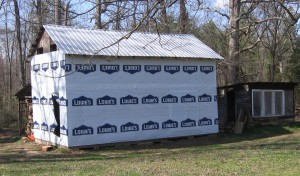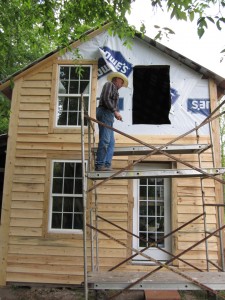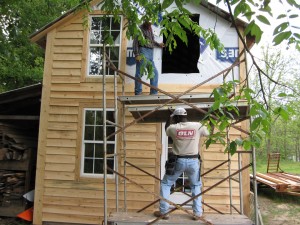Story of a Barn, part 2
I love a good story about an old building, so I will have to hold myself back from making my Story of a Barn series into a novella. Oh… maybe I should just give in to that impulse…
Once the big panel truck took Gordon and all his many possessions to Brooklyn to live I still held out hope, for a while, that he might decide to come back home and finish the barn. But, after a couple of years passed and he signed a five year lease, I realized the barn was going to remain a lumpish half done reminder if I didn’t take it on myself. We negotiated the transfer of his project to me, and I hired some help.
Paul Nelson Hollar is a third generation carpenter. His grandfather built the house I grew up in. His father helped my father with the construction of our mountain house. And Paul had helped me and my brother since we were all very young, with various jobs we undertook. Paul had just finished rehabbing an old tenant farm house for my brother when I asked him if he’d help me put a floor in my barn. He agreed and he and his wife Joan showed up on consecutive Saturdays to work on the framework and put down plywood. We’d have lunch and laugh a lot. Joan could easily be a comedienne. It was like potato chips– I couldn’t stop there. After the plywood we decided to work on the siding, and on installing windows.
Paul knew the owner of the local sawmill and arranged for the wood to be cut, and hauled in. He patiently worked with me, picking up second hand windows and doors, trying to keep the project on a budget I could afford. Out of the attic came the wonderful turn of the century beveled, leaded glass window Paul’s father had given me 30 years before– just because I admired it. I had driven by the Hollar’s house at sunset, and the west-facing window tacked into the shop out back caught the sunlight and refracted it like a thousand diamonds. It was breathtaking. Nelson removed it and gave it to me– because that’s the kind of people they are. Paul and I picked a west-facing wall and figured out where to install it.
Paul is a cowboy and most of the people who work with him are cowboys. Lamont, who helped with the barn, also helped my brother train his beautiful American Paint/ Percheron to wear a bridle and pull a plow. Paul and Joan have a business boarding and caring for horses on the grounds of their early 18th century home. They come out of that culture– love of the land, love of the old ways, abject honesty, total integrity, and a strong belief in helping one’s neighbors. Paul grew up on a gentle rise in my rural community, on property that had been farmed by his family for generations. Like many people in our community, all around him were cousins, aunts, and uncles. And it’s still that way. We used to love to get his Aunt Belle to tell us stories of the old days. She told us how our grandfathers would all thresh together. They would go from farm to farm, as a group, threshing. And the womenfolk at whatever farm they were threshing would feed them all that day. It was a competition to see who set the best table. Our community is still known for its fine cooking . It was rural, but it was interdependent– black or white, modest or well-off, everyone depending on the help of the others. Even into our parents’ generation they still participated in barn raisings, and assisted neighbors in need without a second thought. So Paul, almost as an act of neighborly love, took on my project, and gave a lot of care to helping raise my barn. Every Saturday, after he left I would take a photograph of what it looked like and email it to Brooklyn with the subject line “Today”.
All along Paul and Joan asked me “what are you going to do with this barn”. At first I didn’t know. I just knew I wanted to resolve the unfinished quality of it, and I knew that if I coexisted with it, time would tell me what to do. With 10 foot louvered shutters discarded from the 1881 church in our community, I first planned a storage closet, with shutters for doors. I would store tools in the space, and maybe have a covered workshop. In that big expanse of wall I thought I might hang some of my extra paintings, so collectors could see them assembled. But it was a vague plan, without much form.
Things ground to a halt when Paul told me he’d been diagnosed with throat cancer. A cowboy doesn’t take much notice of things like that. He just keeps right on going. He was told it was totally curable, but there has been chemotherapy and radiation and a cure that’s worse than the disease. And just for now, this big old cowboy’s hammer has been silenced.





Recent Comments